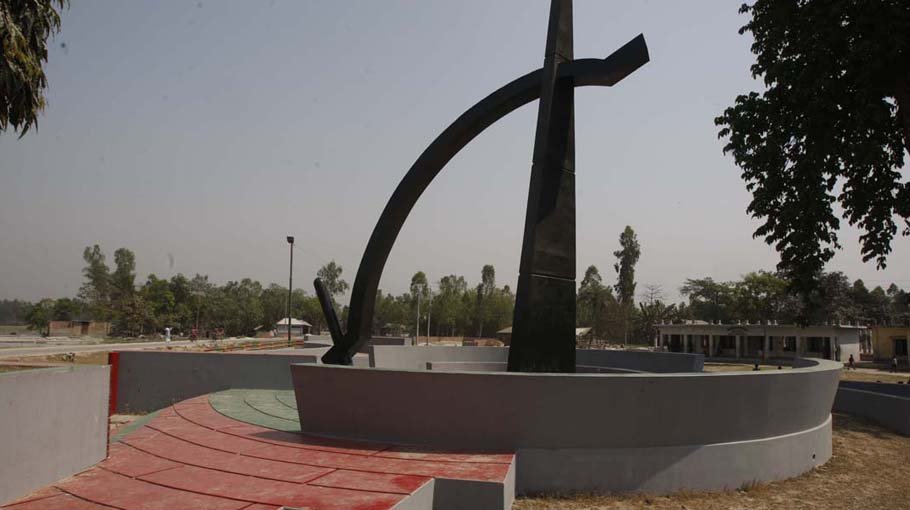Shilpakala Academy to build theatres in all districts to honour martyrs


On the occasion of the golden jubilee of independence, Bangladesh Shilpakala Academy has decided to build environmental theaters in 64 districts of the country. As part of the projects, preparations are underway to build an environmental theater at Nishbetganj in Rangpur district. The final staging of the play, titled 'March 26 '71, will take place on December 20 at 7 pm on the premises of Nishbetganj Government Primary School adjacent to' Rakta Gaurab', a monument which honours the memory of martyrs and freedom fighters of Rangpur.
In 1971, The whole of Rangpur started protesting with processions and slogans. In the procession of protesting people indiscriminately shots were fired, 3 more people including Kishore Shanku were martyred. They were the first martyrs of independence in Rangpur region. Rangpur became turbulent through their blood donation.
Freedom-loving people continue to organize. Armed struggle in preparation. As part of this, the freedom-loving people took the historic decision to encircle Rangpur Cantonment. The day was exactly March 26. Drums were beaten at various markets in Rangpur calling for people to join the siege.
And the response to this call was unprecedented. The cantonment prepared for the attack with whatever it has.
The tribals of Rangpur also started preparing with bows and arrows. The role of the archers Santals of Orano community of Mithapukur upazila was significant in this regard. They joined the siege with bows and arrows, spears, lances and spears.
March 26 is an unforgettable day for the people of Rangpur. The armed struggle of the Liberation War started on March 26, just one day after the official start of the War of Liberation. On this day in '71, the freedom-loving protestors of Rangpur surrounded Rangpur Cantonment with sticks, bows and arrows and gave birth to a unique history.
People from different areas of Rangpur started organizing from morning. As time went, the heat and excitement seem to increase. Thousands of people from different areas of the district including Mithapukur, Baldipukur, Manjai, Ranipukur, Tampat, Palichara, Burirhat, Gangachara, Shampur, Damdama, Lalbagh, Ganeshpur, Damodarpur, Paglapir, Sahebganj have to gather before 11 o'clock in the morning. In their hands were sticks, arrows, bows, spears, lances and axes.
Major Nasir Uddin of the 29th Cavalry Regiment, who was an eyewitness to the incident and was serving in Rangpur Cantonment at the time, described in his book 'Freedom in War' that day, the scene I saw was shocking.
From the south, thousands of people lined up and marched towards the army camp. Each of them has in his hand all the ordinary weapons like scissors, bow and arrow, spear, spear. It was quite understandable that they were all locals. The people lined up are moving towards the cantonment like ants. At that moment, a dozen jeeps came out of the cantonment and machine guns started firing at the procession. In just 5 minutes all around became silent. Thousands of bodies remain in the field. The people scattered in the field after being shot were dragged and gathered in one place to be burnt. But the Punjabi junta was annoyed by the moans of the survivors. In order to control this situation, they were busy stabbing them with bayonets and stopping them forever.
The sky of the whole area seemed to become heavy with the screams of the injured. His statement further said, "500 to 600 bodies were poured petrol and cremated as instructed earlier that evening. The fire blazed.
This fire was much more red than any other fire. This external flame burned much more. I was watching the fire from afar - how the helpless human child of freedom is burning. '
On March 26, the people of Rangpur woke up with a new consciousness. In the history of the War of Liberation, the attack on the cantonment of Pakistani hyenas with bamboo sticks and bows and arrows is rare in the history. Such an incident happened on that day by the brave people of Rangpur.
The freedom-loving people of Rangpur started the great war of liberation by encircling the cantonment. This is their first battle against the Pak aggressors on March 26. But sad but true, the recognition of that sacrifice of that day did not match nationally even today. However, a monument called 'Rakta Gaurab' was erected in 2003 in the historic Nisbetganj area where the self-sacrificing people were last gathered during the siege of the cantonment, which still stands silently today. Cantonment Siege Day is celebrated on this day every year with various programs initiated by the local people.
Preparations are underway to build an eco-theater with the 'Rakta Gaurab' bandhbhumi, written by Sumit Mohant and directed by Razzak Murad, based on the unique history of the siege of Rangpur Cantonment.
The play will be performed by District Shilpakala Academy Repertory Drama Group on March 26, 1971 in collaboration with Rangpur District Administration and managed by District Shilpakala Academy.
In this regard, Nujhat Tabassum Remu, Cultural Officer, District Shilpakala Academy, said that Bangladesh Shilpakala Academy, under the patronage of the Ministry of Culture, has decided to build an environmental theater in 64 districts of the country.
As part of this, 'Rakta Gaurab' will be staged in Rangpur on March 26, 1971. Through which future generations will be able to know the unique history of Rangpur Cantonment siege.



